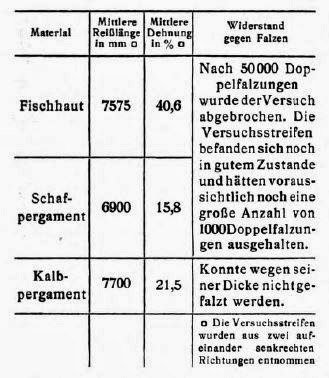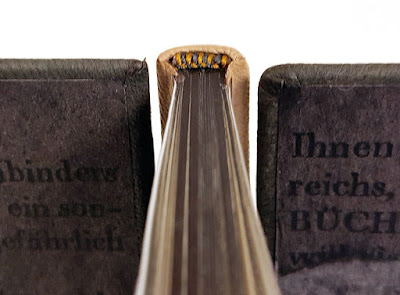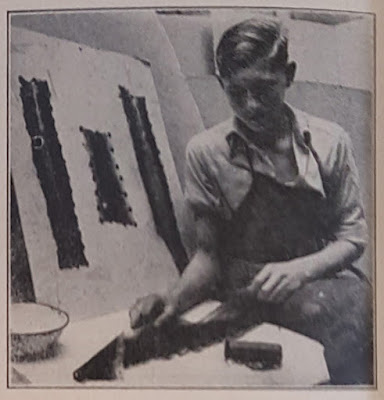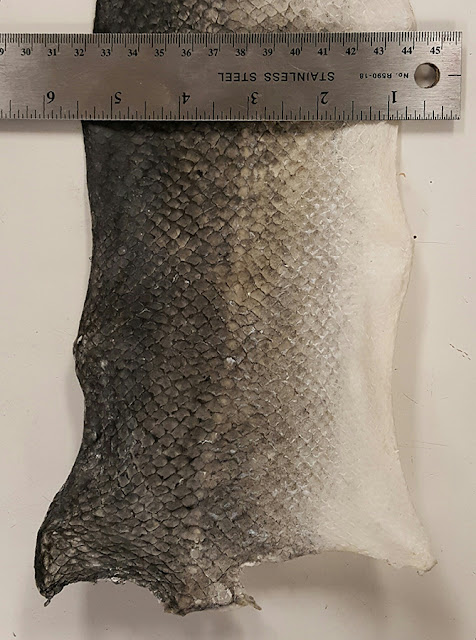In 1919, after the end of World War I, there were severe shortages and civil unrest in Germany. This situation repeated itself after World War II. These shortages led to a high level of experimentation with ersatz (replacement/alternative) materials such as straw for paper and board, spun paper, ..., silk instead of linen for sewing thread, but also colored straw for inlays (Strohintarsien). Ernst Collin and others wrote articles on the subject in such periodicals as the
Archiv für Buchgewerbe, the
Buchbinderlehrling, and the
Allgemeiner Anzeiger für Buchbindereien. This post is about one of those "ersatz" materials, fish leather.
In "
Fischhaut zu Bucheinbänden" from the
Archiv für Buchgewerbe ( Vol. 56, 1919) the bookbinder Franz Martini of Charlottenburg (Berlin) recounted a war experience in which he saw cod skins that had been pulled off the fish in a field kitchen in Belgium and discarded. Drawing on his experiences at the bindery of Lüderitz and Bauer, he examined the skins to ensure there were no cuts/tears, then carefully removed the scales and made parchment from them, using them to bind various such as military journals. Based on these experiments he deemed the fish parchment superior to calf or sheep for durability and working properties such as the ability to mold over raised cords without wrinkling.
Martini had the leather tested at the national testing center on the recommendation of Paul Kersten (Director of the School for Artistic Bookbinding in Berlin), and the Director of Royal Library of Berlin. The results of this testing were impressive, especially in terms of fold and tear strength where the fish parchment easily reached 50,000 double folds without damage.
 |
Material: Fish skin (untanned), sheep parchment, calf parchment
Mittlere Reißlänge in mm = average breaking length in mm
Mittlere Dehnung in % = average stretching in %
Resistance to folding. |
After these tests Martini also developed a way to tan these fish skins
to leather, also taking out a "utility model" (Nr. 674 741), a more
limited form of patent, on this invention. Below some images of bindings
he created with these tanned skins from the
Archiv für Buchgewerbe. Obviously, fish skins are most suited to half/quarter bindings due to their shape... Images from
Archiv für Buchgewerbe ( Vol. 56, 1919).
 |
| Half-leather extra binding with leather onlay and original pastepaper |
 |
| Half-leather extra binding with leather onlay and original pastepaper |
In the 1934
Allgemeiner Anzeiger für Buchbindereien (Vol 49, Nr 19), Ernst Collin wrote an article titled
"Bucheinbände aus Fischhaut" ("Bookbindings in Fish Leather") that described the process in more detail, illustrated with photographs by Ernst. Shown is the same
Franz Martini as mentioned above demonstrating how to remove the skin
from the fish and prepare it. Martini has been able to demonstrate the effectiveness of tanning fish on a variety of species including cod, halibut, shark, eel, and others. Ernst points out that one of the reasons fish leather is not common is that most consumers prefer to cook the fish with the skin on - he suggests wrapping in gauze for the same effect, the cooking method is not mentioned.
The article recaps an earlier article by Paul Kersten from the 1917 (Nr 7)
Allgemeiner Anzeiger für Buchbindereien
which was similar to the 1919 article mentioned above. Ernst's article
also states that Martini's attempt to patent the process failed as it
was not unique enough and had been described in earlier publications.
Ernst concludes by praising this material and encouraging the German fisheries to take advantage of the need for durable yet affordable native materials to help contribute to sustainability and German economic independence.
The 1938 volume of the
Buchbinderlehrling, a periodical for apprentices, describes the manufacture of fish leather in the context of the 4-year plan to make Germany independent of imports, and increased rationing in advance of the looming war...
The fish were carefully skinned and then tanned in rotating drums using a vegetable tannage - sumac,
dividivi, or willow. Unfortunately the tannins in most domestic plants were not effective enough. To dye the skins, aniline dyes and pigments (for darker colors) were used. Finally, the leather is pressed and glazed. Overall, these processes are identical to tanning other animal skins with an equivalent quality possible. Fish leather retains its flexibility and softness. It is also very resistant to tearing.
The article concludes by reminding the upcoming bookbinders that this is a material that they will need to become comfortable with, just as all other binding materials.
A
final article on the subject from the 1946 (Nr 12) issue of the
Allgemeiner Anzeiger für Buchbindereien leads with "Fish Leather Developed by Bookbinder." It recaps the articles mentioned above, and concludes by saying fish leather has established itself as a binding (and other leather trades) material, but no one remembers that a bookbinder first developed it.
Images of fish leathers below from my leather "stores." Of these the eel is the thinnest and smoothest by far, and only really useable on millimeter bindings, on small/light books, or for onlays. Almost no paring is required for use.
The other fish leathers, trout, salmon, cod, and carp are available glazed and suede. Paring is possible, but what I've found most effective is pasting out the back for dimensional stability and letting it dry on Mylar. Peel off and sand (a
"micro" belt sander is great) with a little edge-paring. These leathers can easily be used as a structural element of the binding, just as any other leather - they're not just for onlays...
 |
| Click to enlarge |
 |
| Click to enlarge |
 |
| Click to enlarge |
The dogfish/shark and stingray skins are very difficult to pare, the former being very rubbery - kills Scharfix blades, fast. The stingray is very hard and best used as an in/onlay. Cutting with a knife also very difficult. Probably the reason I haven't used it yet. Abigail Bainbridge wrote a great description of working with shagreen for the West Dean College
Current Projects blog.
 |
| Click to enlarge |
Below examples of bindings using fish leather that I have made. Click image to enlarge.
 |
On Søren Kierkegaard by Edward F. Mooney
Bound in salmon leather on spine with stained birch veneer covered boards; endpapers
of handmade Roma paper; graphite top edge; leather endbands; title stamped in
gold on front cover with goat leather onlays. Enclosed is cloth-covered slipcase. Bound 2013. |
 |
The Book of
Origins – Le Livre des Origines, André Ricard,
2004
Modified Bradel binding (Gebrochener Rücken); textblock
sewn on three slips of Cave Paper brown walnut dyed paper; endpapers
of Cave Paper brown walnut dyed paper; gilt top edge; sewn silk
endbands; Bradel case with 1/4 veined calf vellum spine and undyed
goatskin sides; slips laced through at joint; decor of codfish
leather onlay and blind tooling.
22.5 x 14.5 x 2.5 cm. Bound 2005.
Collection of Karen Hanmer. |
 |
Gaylord Schanilec and Clarke
Garry, Mayflies of the Driftless Region, Midnight Paper
Sales Press, 2005
“Open joint” binding; sewn on 3 brown salmon leather
slips; flyleaves and doublures of Cave Paper “layered indigo
day” paper; graphite top edge; rolled endbands brown salmon
leather; spine covered in gray salmon leather; boards covered in
full vellum with printed illustrations from text below; salmon leather
slips attached to boards and framed with decorative weathered wood
veneer; tied mayfly attached to front board. 26.5 x 19 x 2 cm. Bound
2013. |
 |
Ladislav
Hanka, Remembering Jan Sobota, 2013
Modified Bradel binding (Gebrochener Rücken); layered Indigo
Night Cave Paper endpapers; sewn link stitch on 5 reinforced slips
of same paper as ends; endbands of endpaper paper around core; spine
covered in brown Kangaroo with cutouts to reveal slips and sewing;
boards covered in brown tie-dyed Pergamena deer parchment; onlays
of suede Salmon leather with fishing fly mounted into lacuna in
parchment; title stamped in gold on front board. 33 x 25.4 x 1 cm.Bound
2013. |













































